Cryptocoryne, commonly known as “Crypt”, is a genus of aquatic plants from the family Araceae.
With over 60 species, Cryptocoryne offers a variety of shapes, sizes, and colours, adding diversity and aesthetic appeal to any aquarium setup.
This guide will give you a comprehensive understanding of these plants, helping you to maintain a vibrant and thriving aquascape.
Related:
- 15 Types of Cryptocoryne For Your Aquarium
- 16 Awesome Background Aquarium Plants
- The 12 Best Carpeting Plants for Your Aquarium
- 18 Types of Aquarium Moss: Photos, Care, Propagation & Growth Guide
Table of Contents
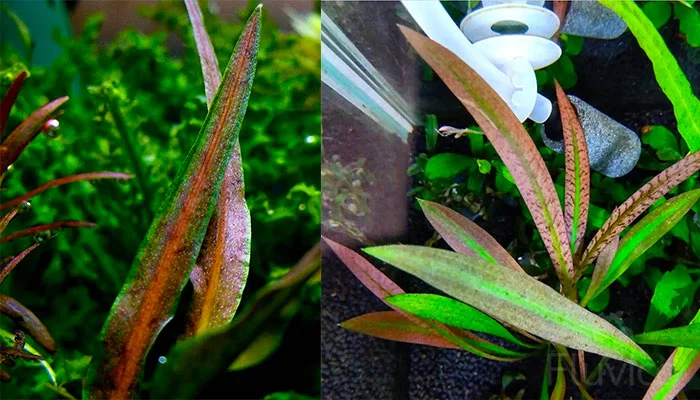
Pros & Cons of Adding Cryptocoryne to Your Aquarium
Before diving into how to care for new Crypt, let’s weigh up the advantages and potential challenges of introducing this plant to your tank.
Pros:
- Variety: Cryptocoryne plants come in many forms, offering a wealth of diversity for your tank.
- Hardy: Crypts are known for their resilience and ability to adapt to different water conditions.
- Low-light Tolerant: These plants do not require high light levels, making them a suitable choice for most aquarium setups.
- Help Improve Water Quality: Like all plants, Crypts absorb excess nutrients and release oxygen, improving water quality and helping control algae.
Cons:
- Initial Melting: Crypts are notorious for “melting” or shedding their leaves when first introduced into a new environment. However, they typically recover with proper care.
- Slow Growers: While some aquarists see this as a pro, others might find the slow growth rate a bit frustrating.
- Need for Root Nutrition: Crypts are heavy root feeders, requiring a nutrient-rich substrate or root tabs for optimal health and growth.
Common Types of Cryptocoryne
With a vast range of species to choose from, you’re sure to find a Crypt that fits your needs and looks great in your aquarium.
We created a Types of Cryptocoryne Guide Here! Check it out for details on Appearance, Light levels, Size, Growth Speed, CO2 Requirement & Colours.
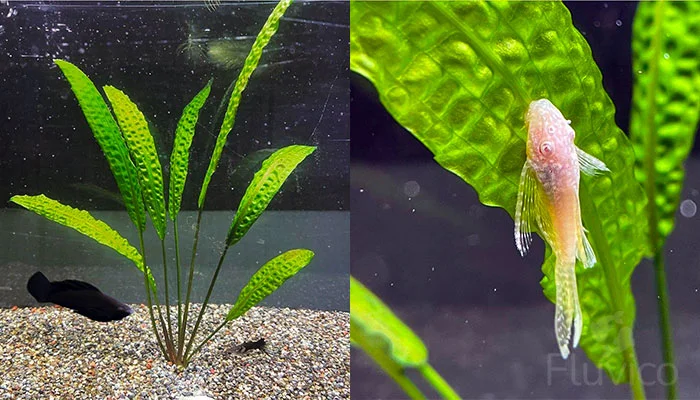
Water & Light Parameters for a Healthy & Fast Growing Cryptocoryne
When it comes to growing healthy and thriving Crypts, maintaining the right water and light parameters is essential. Let’s take a look at these parameters:
- Water Parameters: Cryptocoryne plants are not too demanding in terms of water parameters. They can thrive in a wide range of conditions, but the ideal parameters are:
- pH: Crypts prefer slightly acidic to neutral water, with a pH range between 6.0 and 7.5.
- Temperature: These plants do best in temperatures between 22°C and 28°C (72°F – 82°F).
- Hardness: They can handle a general hardness (GH) anywhere between 3 and 20 dGH. So whether your water is soft or hard, your Crypts should do fine.
- Light Requirements: Crypts are low-light plants. They can do well under moderate lighting, but too much light can cause problems such as algae growth. If you’re using artificial lighting, aim for about 10-14 hours of light per day.
- Nutrients: Crypts are heavy root feeders. While they can get some nutrients from the water column, they’ll benefit from a nutrient-rich substrate or root tabs. Ensure they’re getting a good balance of macro and micronutrients.
- CO2: While not strictly necessary for Crypts, they will certainly benefit from CO2 supplementation. This can promote more vigorous growth and deeper coloration, especially in red varieties.
Keep conditions stable, and your Crypts will reward you with lush, (albeit slow but beautiful) growth.
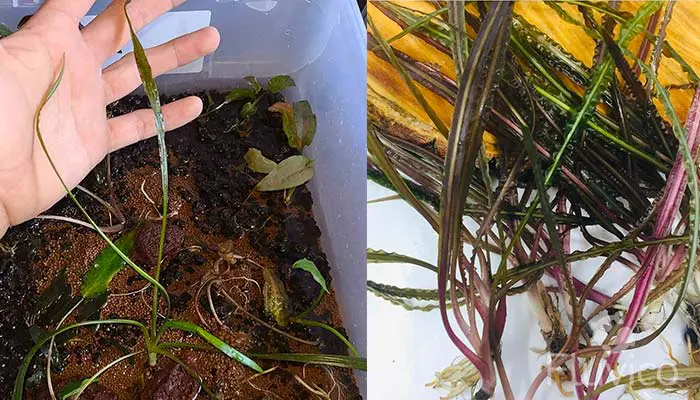
How To Pick A Healthy Cryptocoryne For Your Aquarium?
Selecting a healthy Cryptocoryne for your aquarium is easy. Here’s what you need to look for:
- Vibrant Green Leaves: The leaves should be a vibrant, healthy green, with no signs of yellowing or browning.
- Check the Roots: A healthy Cryptocoryne will have white roots. Brown or mushy roots could indicate a problem.
- Inspect for Pests: Carefully inspect the plant for any signs of pests like snails or parasites that will cause problems later.
- Consider the Size: Consider the size of the Cryptocoryne, taking into account the size of your tank and the intended placement of the plant.
- Quarantine New Plants: As a precaution, quarantine new plants before introducing them to your main tank to ensure they are free from diseases or pests.

Are Cryptocorynes root feeders & do they need root tabs?
Yes, Cryptocoryne plants are indeed root feeders.
What this means is that they take up a large portion of their required nutrients directly from the substrate via their root system, rather than from the water column.
This makes the quality of the substrate you use in your aquarium particularly important for Crypts. Providing a nutrient-rich substrate, or supplementing with root tabs, will ensure that these plants thrive.
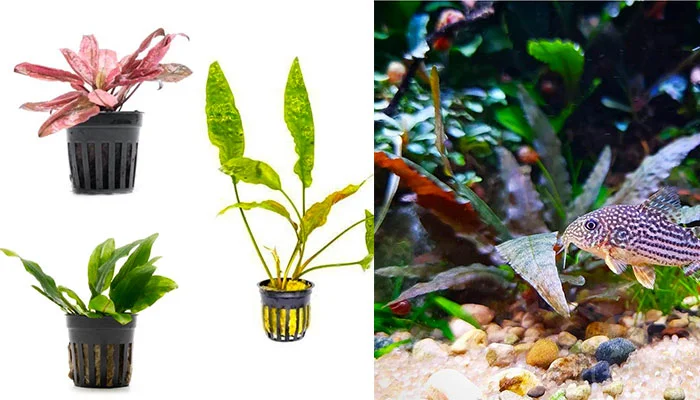
Understanding Cryptocoryne Melt & How to Fix It
Cryptocoryne Melt, or simply Crypt Melt, is a common issue. But fear not, it’s not the end of the line for your plants. Here’s what you need to know:
- What is Crypt Melt? Crypt Melt is where a the plant loses its leaves suddenly. You’ll notice the leaves becoming transparent and then disintegrating, leaving only the root system and the stub of the stem.
- Why does it happen? The melt often occurs when there’s a significant shift in their environment – changes in lighting, water parameters, or even being moved can be a trigger.
- What to do when it happens?: If your Crypt starts to melt, the best thing to do is to keep calm and leave it alone. Remove the decaying leaves to prevent them from fouling the water but leave the roots in place.
- How to fix it: There’s no instant fix for Crypt Melt, but patience pays off. Keep the water parameters stable, provide sufficient lighting, and continue your regular fertilization routine. Over time, new leaves will sprout from the roots that have acclimated to the new conditions.
Remember, Crypt Melt is a common occurrence and not a plant death sentence. With a little patience and care, your Crypts will bounce back even stronger.
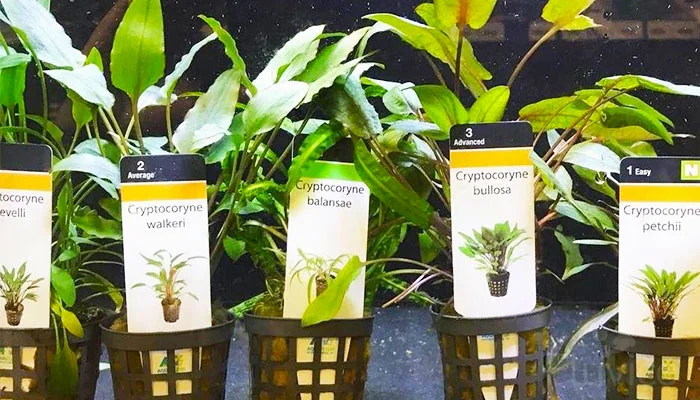
How to Propagate Cryptocoryne like a Pro?
These plants are pretty low maintenance and easy to propagate. Follow these simple steps and you’ll have yourself some free crypt plants.
- Wait for the Runners: Crypts naturally propagate by sending out ‘runners,’ which are horizontal stems from which new plants (plantlets) grow. Watch for these runners, and the tiny plantlets that form along them.
- Let the Plantlets Grow: Allow the plantlets to grow while still attached to the parent plant until they have formed a good root system of their own. This may take a few weeks.
- Cutting Time: Once the new plantlets have a robust root system, you can cut them away from the runner.
- Plant the New Crypt: Once separated, you can plant the new Crypt in your substrate. Ensure the roots are well covered, but the crown of the plant (where the leaves join at the base) should not be buried to avoid rot.
- Provide Optimal Conditions: Now, treat this new plant just like your other Crypts. Give it the right lighting, water conditions, and nutrients, and it will start to grow into a full-sized plant before you know it.
Remember, successful propagation is all about providing a healthy, stress-free environment for your Crypts. Happy propagating!
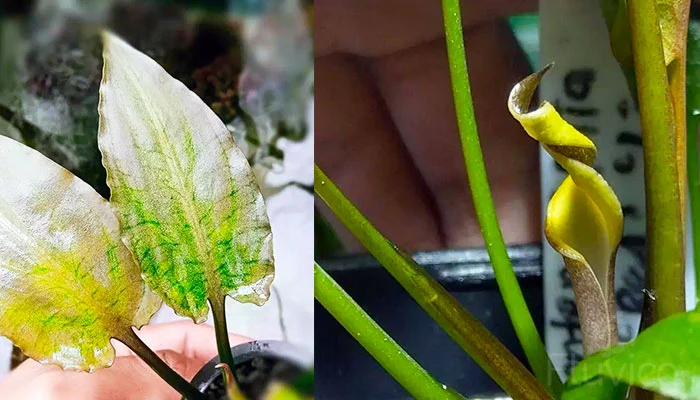
Cryptocoryne FAQs
Are Cryptocoryne plants good for Beginners
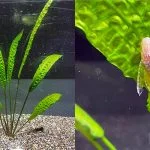
Absolutely! Crypts are sturdy, adaptable, and thrive in a wide range of conditions, making them an excellent choice for beginners.
Is Cryptocoryne safe for all fish?
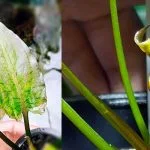
Yes, Crypts are generally safe for all fish, including herbivorous fish, though it’s always a good idea to research specific fish species’ compatibility with plants.
Is Cryptocoryne safe for Turtles?
Crypts can coexist with turtles; however, some species might nibble on the plants. As with fish, it’s best to research the specific turtle species’ habits before adding Crypts to your tank.
Does Cryptocoryne need Co2?

While Crypts can benefit from CO2 supplementation, they don’t necessarily require it. These plants can thrive in a range of conditions and are generally quite adaptable.
Why won’t your Cryptocoryne Grow?

Crypts can sometimes experience periods of slow growth or stasis. Factors such as inadequate lighting, nutrient deficiency, or major changes in their environment can be potential causes.
Do Cryptocoryne Plants Flower?
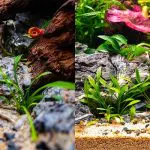
Yes, Crypts can produce flowers even in an underwater environment. The flowers are usually white and appear on a spike (known as a spathe) from the base of the plant.
Why are my Cryptocoryne leaves turning yellow?
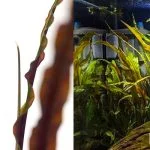
Crypt leaves can turn yellow due to nutrient deficiencies, particularly a lack of iron, low light conditions, excess algae growth blocking light, or simply because the leaves are aging and will soon be replaced by new growth.
Why are my Cryptocoryne leaves turning light green?

Light green leaves can be a sign of healthy new growth. However, if older leaves are losing their color, this could signal a nutrient deficiency.
What color are healthy Cryptocoryne leaves?

Healthy Crypt leaves are usually a vibrant green, although some species and varieties may have brown or reddish hues.
Is it okay to let Cryptocoryne float?

Crypts are typically substrate-rooted plants and do best when planted. However, they can technically float for a short while until you’re able to plant them properly.
Can Cryptocoryne grow out of water?

Yes, Crypts can grow emersed (out of water) and are often cultivated this way. This flexibility makes them a popular choice for paludariums and terrariums as well.
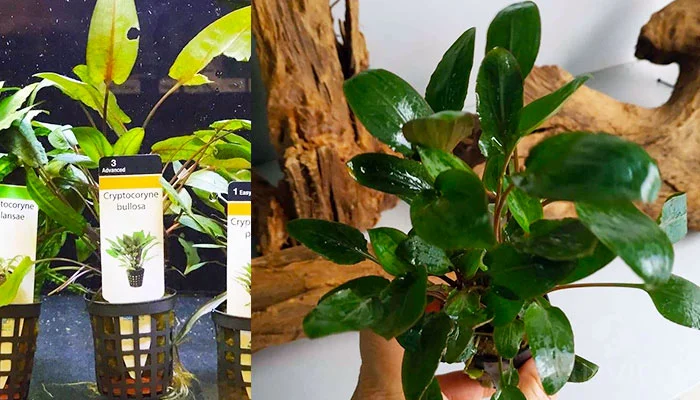
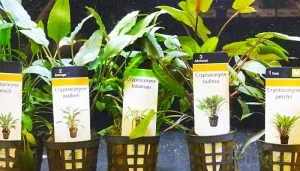
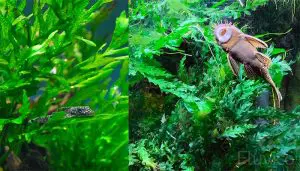

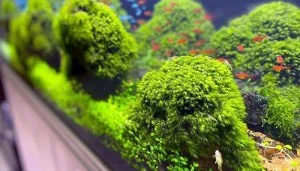
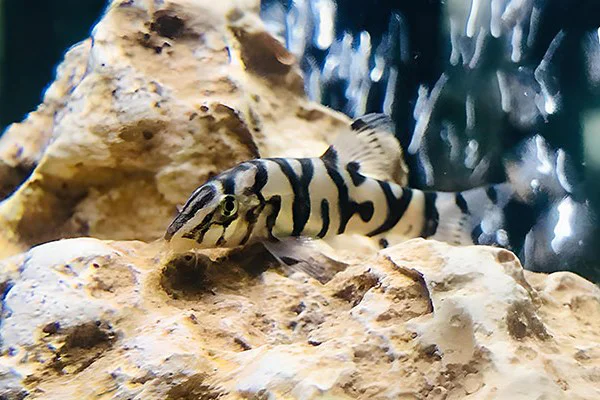
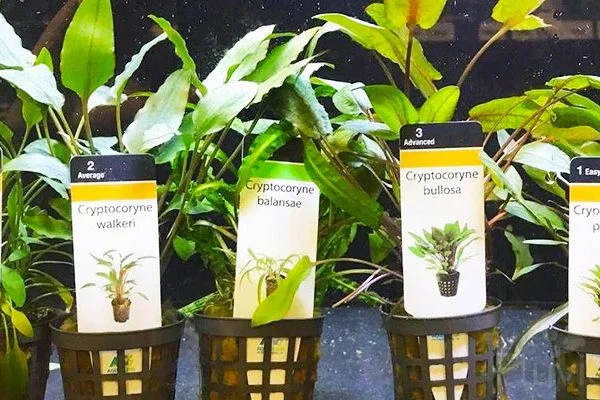

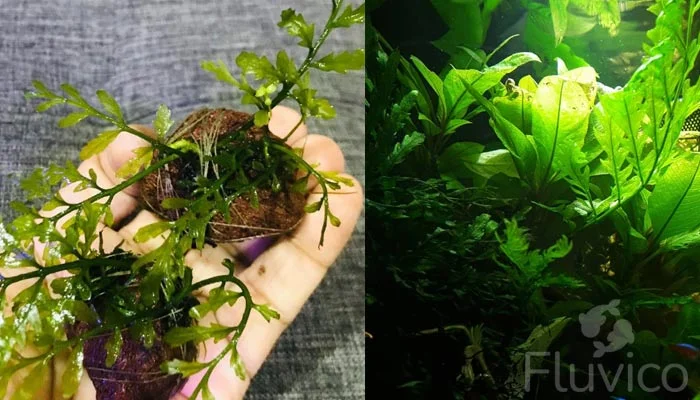
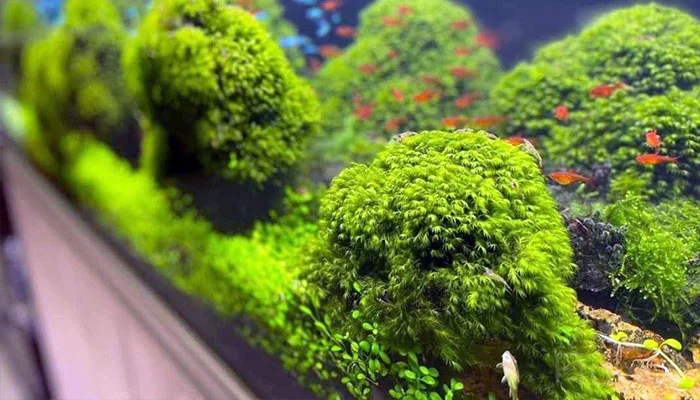
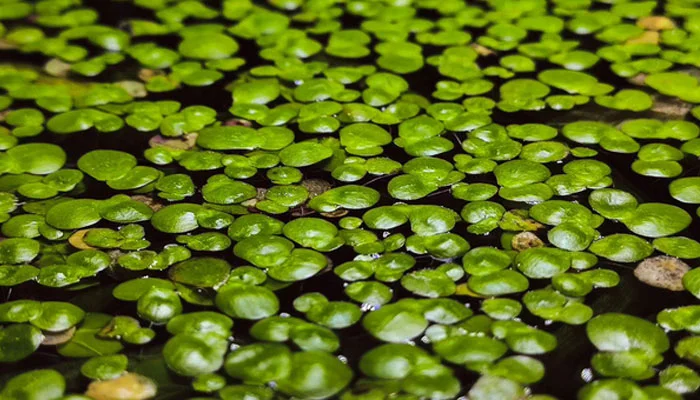
Hope you enjoyed our Cryptocoryne (Crypts) Care Guide!
If you have any questions about these wonderful plants? Ask away, we’re here to help!